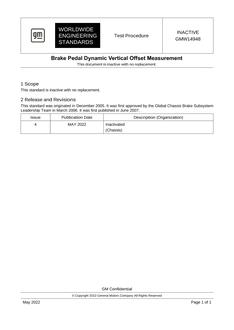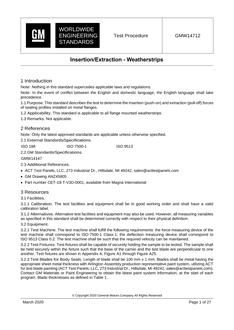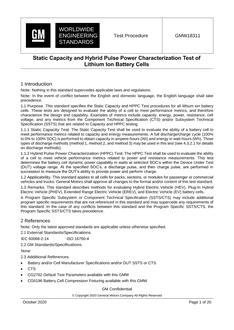-
-
Available Formats
- Availability
- Priced From ( in USD )
-
Available Formats
-
- Immediate download
- $93.60
- Add to Cart
-
- Printed Edition
- Ships in 1-2 business days
- $93.60
- Add to Cart
Customers Who Bought This Also Bought
-

GMW GMW14948
Priced From $93.60 -

GMW GMW16394
Priced From $51.60 -

GMW GMW14712
Priced From $51.60 -

GMW GMW18311 + SUPPLEMENT(S)
Priced From $93.60
About This Item
Full Description
Note: Nothing in the specification supersedes applicable laws and regulations unless specific exemption has been obtained.
Note: In the event of conflict between the English and domestic language, the English language shall take precedence.
Purpose. To perform component and subsystem level validation for squeak and rattle noises, when subjected to a vibration spectrum comparable to 'in-vehicle' vibration.
Forward. This test is limited to detecting vibration induced noises, excited by inputs above 8 hertz. Squeaks or itches excited only by slow body twist (cross ditches or driveways) will not be addressed by this test. Additionally, impact type vibrations caused by a door, hood or rear compartment lid slam cannot be addressed by this test.
Please refer to the Squeak and Rattle Subsystem/Component Technical Specification (SSTS/CTS) for the vibration test criteria and objective in-stationary Loudness criteria or subjective evaluation criteria.
Applicability. This procedure is applicable to any automotive component or subsystem where squeaks and rattles are a concern and the vibration environment can be simulated.
Definitions.
PSD. Power Spectral Density is a plot of acceleration versus frequency. The acceleration values have the units of (m/s²) ² /Hz.
N-Sigma Clipping. N-Sigma clipping occurs when the peak amplitude is cut-off based on a normal statistical distribution limit. Often 3-sigma clipping is selected.
Instationary Loudness. Loudness (sones) involves linearization of subjective perception of the loudness of acoustic signals. The unit of loudness, the sone, corresponds to a sine tone of frequency 1 kHz and a level of 40 dB. Tones twice as loud (perceived as such) have the loudness value 2 sones, tones three times as loud have the value 3 sones, and so on.
N10 Loudness. N10 Loudness is a statistically calculated Loudness value based on the 90th percentile value of the time varying loudness values. The 90th percentile means that 10% percent of the population has a value greater than the N10 value and 90% of the population has a value that is less.
Document History
-
GMW GMW7293
Subjective Subsystem/Component Squeak and Rattle Test- Most Recent
-
GMW GMW7293
Subjective Subsystem/Component Squeak and Rattle Test- Historical Version
-
GMW GMW7293
Subjective Subsystem/Component Squeak and Rattle Test- Historical Version
-
GMW GMW7293
Subjective Subsystem/Component Squeak and Rattle Test- Historical Version
-
GMW GMW7293
Subjective Subsystem/Component Squeak and Rattle Test- Historical Version
-
GMW GMW7293
currently
viewing
Subsystem/Component Squeak and Rattle Test- Historical Version
-
GMW GMW7293
Subsystem/Component Squeak and Rattle Test- Historical Version





